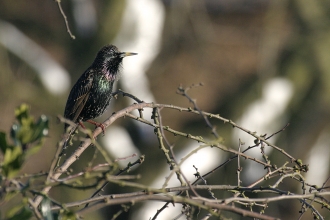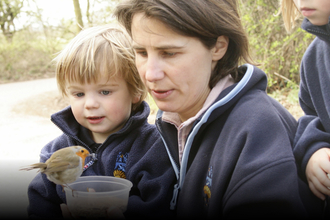Starlings are common garden visitors that have a beautiful purple and green sheen to their black feathers. These sociable birds have a wingspan of 40cm, length of 22cm, weigh just 78g and have an average lifespan of 5 years. Starling eats insects and fruit and will visit your bird tables and feeders. These birds really do live alongside us in our gardens and towns, but also make their homes in grasslands, wetlands, moorlands and woodlands. Usually in holes in trees or in buildings, their nests are untidy! The female starling lays between five and seven eggs and both parents will raise the chicks together.
Starling Murmurations

During the winter months, large numbers of starlings visit Britain from the continent, seeking out the relative warmth of our island climate. As dusk arrives, the starlings set off for their communal roost in one of the most staggering natural spectacles of all. Flocks arrive from all directions, after a day of looking for food, gathering in the skies above their roost sites. As the numbers reach into the tens and hundreds of thousands, the ‘murmurations’ (the name for a flying flock of starlings) take on incredible shapes in the sky. With each bird having reflexes of under 100 milliseconds, they can rapidly change direction without crashing, creating the hypnotic cloud-like movements, swirling back and forth in ever more complex and beautiful patterns.
This starling murmuration took us by a surprise in Rutland water couple days ago @WildlifeTrusts @LeicsWildlife @Britnatureguide #Ourworldisworthsaving #bbcspringwatch #starlings #britishwildlife #naturelovers #NatureisAmazing @Natures_Voice pic.twitter.com/WiJ61fEQPM
— Ann (@Ann__Chris) October 27, 2020
There are many possible reasons as to why they do this. Grouping together offers safety in numbers; predators find it much harder to target one bird when there are many and the hypnotic movement makes this even more difficult. It also helps them to keep warm and exchange information, such as good feeding areas (where is the best bird table!) and reaffirm social bonds. They do this over the roosting sites and as their numbers peak and the light fades, they will suddenly funnel down to their roosts, as is by a secret signal and settle down to sleep.

Starlings at Brandon Marsh Credit Ann Karin Solheim
This is a late Autumn/Winter phenomenon, but murmurations can be seen as early as October and there have even been reports of them happening in September. More birds will flock together as the weeks go by, so November onwards is your best bet for viewing one. Early evening, just before dusk is the key time they occur. Around half an hour before sunset is the latest time to set yourself up, ready at a good vantage point where you can see the roosting site and have a clear view of the sky overhead. They mainly choose to roost in areas that are sheltered from harsh weather and predators; such as woodlands, but reedbeds, buildings and industrial structures are used as well. Our reedbeds at Brandon Marsh are a key site locally. You do not need any specialist equipment to enjoy the show, you just need to look up! Do wrap up warm, as at this time of year the temperature drops with the sunset.
Please share your local sightings with us on Facebook or Twitter! If you are reading from further afield than Warwickshire, take a look at The Wildlife Trust’s recommended sites across the country.

Starling Murmuration at Brandon Marsh credit Mark Phillips (@Markybike )
The sheer size of flocks may make you think that starlings are doing very well, but sadly that is not the case. Years ago starling murmurations were a common sight in winter, over our cities, but now you have a better chance of seeing them in rural areas. Their population has fallen by a massive 80% in recent years resulting in them now being on the critical list of UK birds most at risk and they're protected in the UK under the Wildlife and Countryside Act, 1981. Their decline is thought to be due to loss of pasture, increased use of farm chemicals and shortage of food and nesting sites in many parts of the UK.
How can you help starlings?
Whether you live in town or country, you can help to look after all garden birds by providing food and water for them. To find out more about encouraging wildlife into your garden, visit the wildlife gardening section of the website where there's plenty of facts and tips to get you started. We also sell a range of bird food and equipment at our Brandon Marsh Shop or you can order online.




